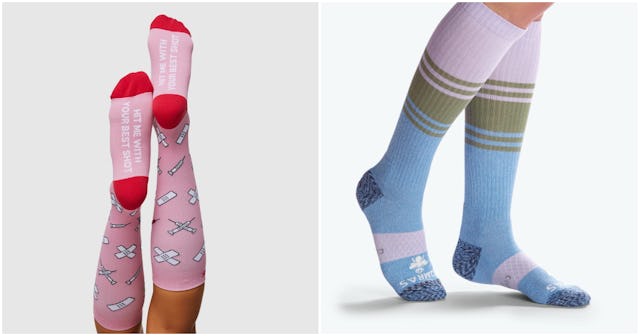The Best (And Cutest) Compression Socks That Help Prevent Inflammation And Edema

So, you’re in the market for compression socks. Lucky for you, you’ve come to the right place. We spend a lot of time using our legs and feet every day — sitting, standing, trying to keep up with pets and children — that it’s inevitable they’re going to be tired or swollen. But that’s where compression socks come in. Many compression socks go over your calves, and while they look somewhat like the knee socks you wore in childhood, they’re designed to help improve the blood flow in your legs to help support them during either leg-intensive activities or if you tend to stand all day. They can’t make life slow down, but they may be able to help your legs keep up with it. If you’re curious why and when you should wear them, as well as how to pick a pair for you, here are some tips.
What do compression socks do?
Compression socks, well, compress your legs and aid in “preventing and treating inflammation or edema (the accumulation of fluid in the legs) from overuse injuries, electrolyte imbalance, or other causes such as venous insufficiency (when your leg veins don’t function properly, which can result in swelling,” says New York City Podiatrist Dr. Nelya Lobkova, DPM at Step Up Footcare. Because they can help in the rehabilitation and recovery of muscles, tendons, and ligaments, wearing compression socks can help treat inflammation in the foot and ankle.
There are many use cases for them: during running or high impact activities to prevent overuse of tendons; during long periods of standing to prevent tired and swollen feet; during pregnancy to prevent or decreasing the pooling of fluid legs (resulting in swollen feet). Dr. Lobkova also adds that compression socks are measured in mm of Hg (millimeters of Mercury) — the higher the mmHg, the more compression delivered to the legs and feet.
What should you look for in a pair of compression socks?
- Compression level: Dr. Lobkova recommends patients with venous insufficiency to wear compression socks at least 30 mmHg; below that, compression is effective in preventing but not treating swollen feet. She says athletes could wear at least 15 mmHg compression socks to prevent overuse injuries.
- Fit: It’s important to buy compression socks that measure your calf circumference,” says Dr. Lobkova, who recommends looking at www.discountsurgical.com to buy socks. The length of the sock will also depend on where your problem is. “For example, those with venous blockage in the thigh must wear compression socks that go above the thigh. The correct length of sock could be determined by seeing a specialist and having a lower extremity diagnostic ultrasound test.” For athletes and runners, she advises knee-length as a starter sock.
- Material: “I also advise diabetics, patients with skin ulcers (skin wounds), and patients with venous problems to purchase cotton compression socks instead of synthetic materials to prevent irritation of skin,” says Dr. Lobkova.
- If you have any questions on length or how to use compression socks, consult a specialist for advice.
Best Compression Socks
Best Compression Socks for Nurses
Best Compression Socks for Swelling
Best Compression Socks for Men
Best Compression Socks for Running
Best Compression Socks for Standing All Day
SHOP THE STORY